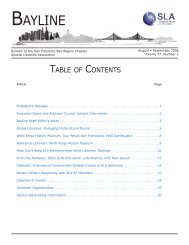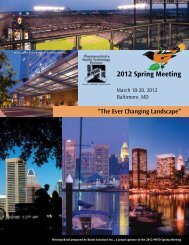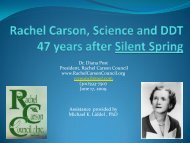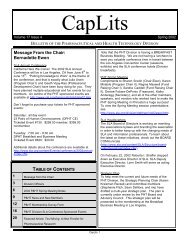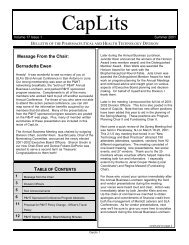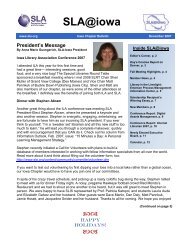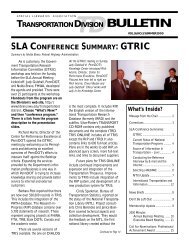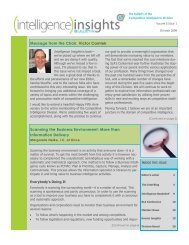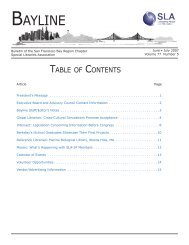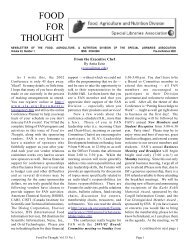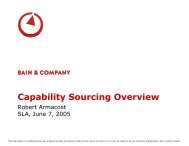Education Libraries - Special Libraries Association
Education Libraries - Special Libraries Association
Education Libraries - Special Libraries Association
Create successful ePaper yourself
Turn your PDF publications into a flip-book with our unique Google optimized e-Paper software.
year prior to Meyer's<br />
arrival to sixteen requests<br />
during her first year at EWU<br />
<strong>Libraries</strong>.<br />
Outreach is a significant part<br />
of Meyer’s responsibility as<br />
learning resource librarian.<br />
As liaison to the education program and related<br />
endorsement programs, Meyer spends<br />
considerable time outside the library, visiting<br />
faculty in their offices. This method has been<br />
productive for learning about new programs and<br />
classes, for sharing common concerns, and for<br />
changing perceptions of the Curriculum Center<br />
and its services. As one faculty said in an<br />
introduction to another member of her department,<br />
"This is Nadean Meyer, a librarian who comes to<br />
my office."<br />
A Visioning Process<br />
Prior to 2006, the Curriculum Center at EWU<br />
<strong>Libraries</strong> did not have a mission statement or<br />
defined goals. A critical step in transforming the<br />
Curriculum Center was to articulate a vision,<br />
values, mission, and guiding principles for the<br />
center, in the context of the both the university’s<br />
mission and the curricular changes for K-12 public<br />
schools in Washington.<br />
As context for the visioning process, Meyer<br />
conducted an environmental scan for the<br />
Curriculum Center, including a review of the<br />
library literature. A key document in the<br />
transformation process has been The Guidelines<br />
for Curriculum Materials Centers, published by<br />
the <strong>Association</strong> of College and Research <strong>Libraries</strong><br />
(2003). The guidelines recommend best practices<br />
for the administration, services, and collections of<br />
curriculum material centers. Meyer joined the<br />
electronic discussion list (EBSS-<br />
L@listserv.ncce.edu) of the association’s<br />
<strong>Education</strong> and Behavioral Sciences Section<br />
(EBSS) as a source of current information about<br />
curriculum centers. Meyer also visited nine area<br />
curriculum centers and education libraries, and she<br />
took a virtual tour of at least ten more curriculum<br />
centers.<br />
As one faculty said in an<br />
introduction to another member<br />
of her department,<br />
"This is Nadean Meyer,<br />
a librarian who comes to my office."<br />
In Fall 2006, Meyer met<br />
individually with key<br />
stakeholders (including<br />
EWU faculty and students<br />
in the Department of<br />
<strong>Education</strong>, faculty who<br />
support education across the<br />
disciplines, library faculty<br />
and administrators, and staff of the EWU<br />
Teaching and Learning Center) to identify<br />
essential elements for the vision and mission<br />
statements. She learned that Dean Patricia Kelley<br />
envisioned the center as a resource not only for<br />
education majors, but also for EWU faculty across<br />
the curriculum and for practicing educators.<br />
Meyer also learned that EWU had recently begun<br />
interdisciplinary programs in early childhood<br />
education. These factors suggested a broader<br />
scope for the center to provide learning resources<br />
and services to support education from prekindergarten<br />
through graduate programs (not K-<br />
12, but P-20).<br />
Throughout Fall 2006, Meyer met with Associate<br />
Dean of <strong>Libraries</strong> Julie Miller to draft the vision,<br />
mission, and values statement for the Curriculum<br />
Center. Recognizing the importance of this<br />
foundational document, Meyer and Miller used an<br />
iterative process that took several months and at<br />
least eight drafts. The resulting vision and values<br />
statements capture a long-range view of the<br />
curriculum center; they state where the center is<br />
going and suggest how it will get there:<br />
Vision: The Curriculum Center is a<br />
physical and virtual library where the<br />
EWU community explores quality teaching<br />
resources. The center supports creative and<br />
knowledgeable teacher preparation. The<br />
center is an active learning place where<br />
users easily find resources. The center<br />
promotes multiple approaches of teaching<br />
diverse learning styles and abilities.<br />
Values: The services and resources of the<br />
center demonstrate the value of<br />
collaboration, diversity, and accessibility.<br />
The center promotes methods based on<br />
learners’ needs and technologies that<br />
enhance learning. (See Appendix A)<br />
<strong>Education</strong> <strong>Libraries</strong>, Volume 31, No. 2, Winter 2008 21



